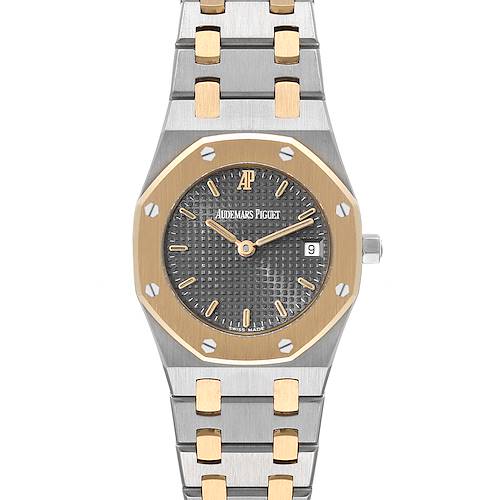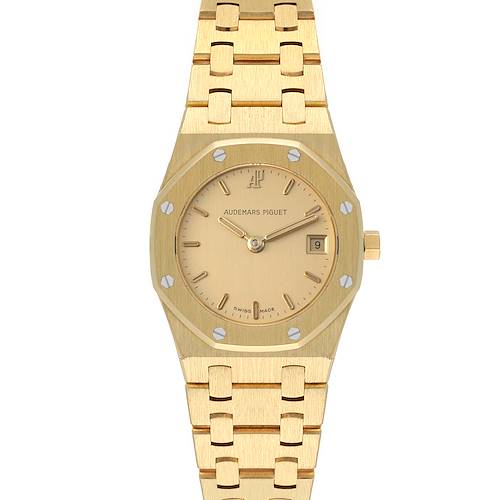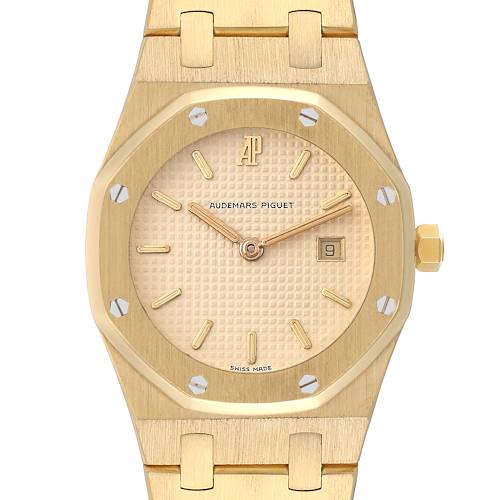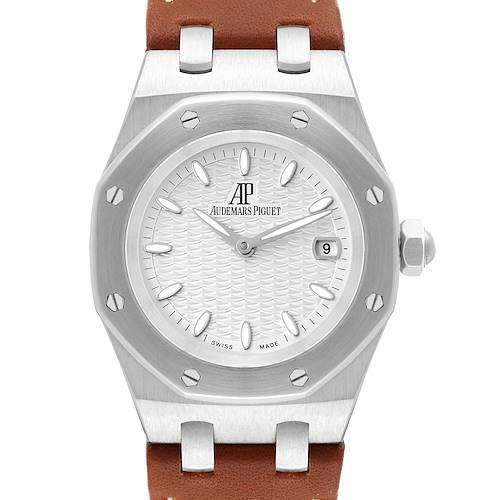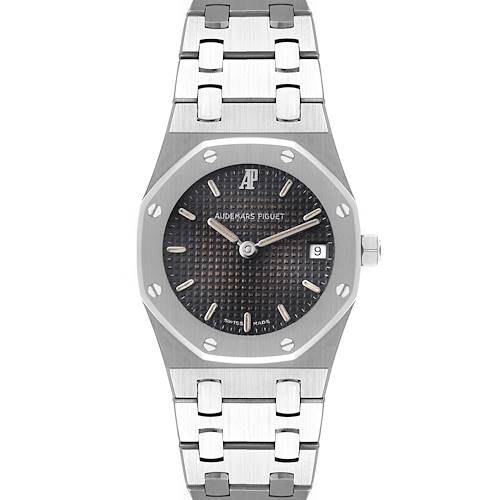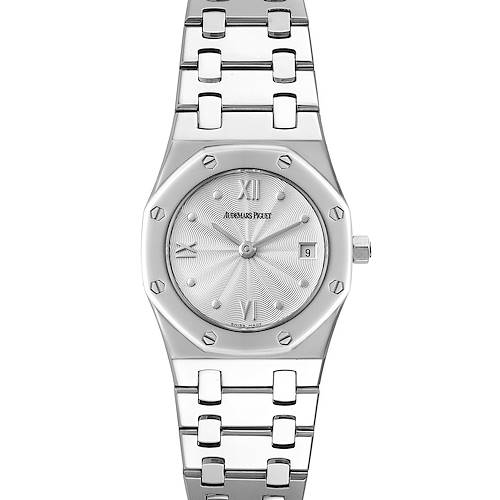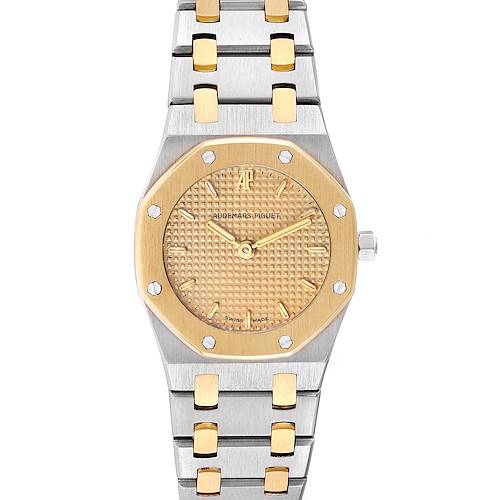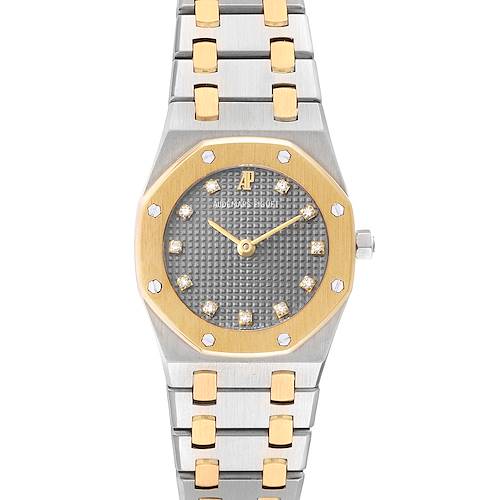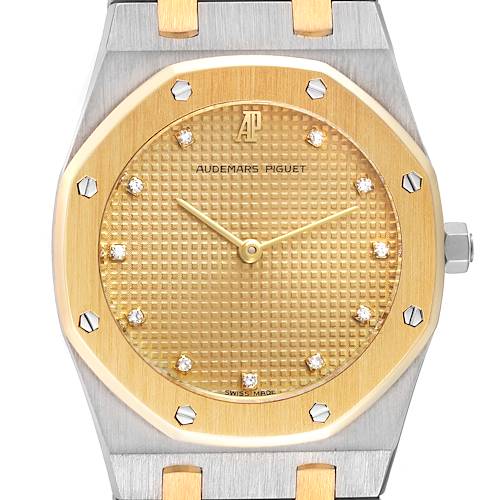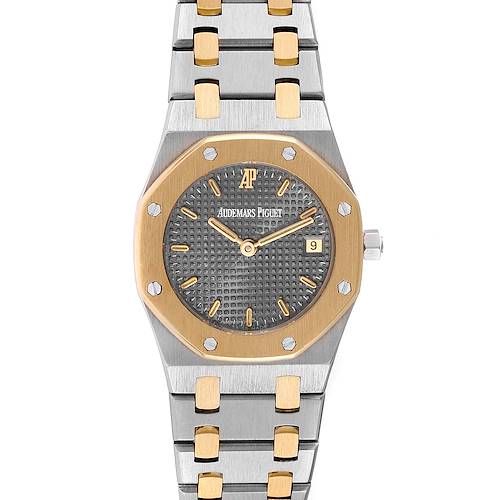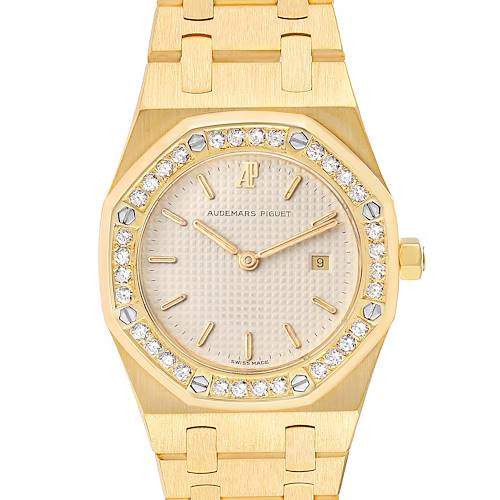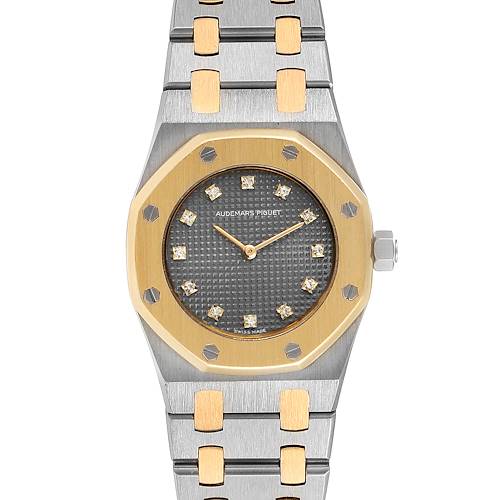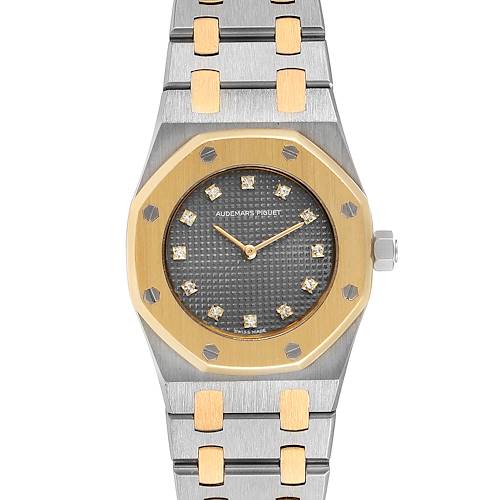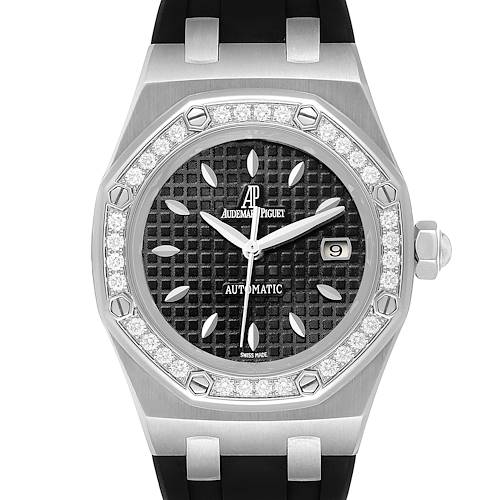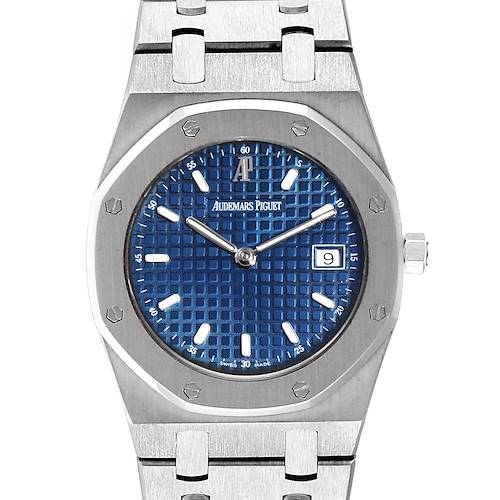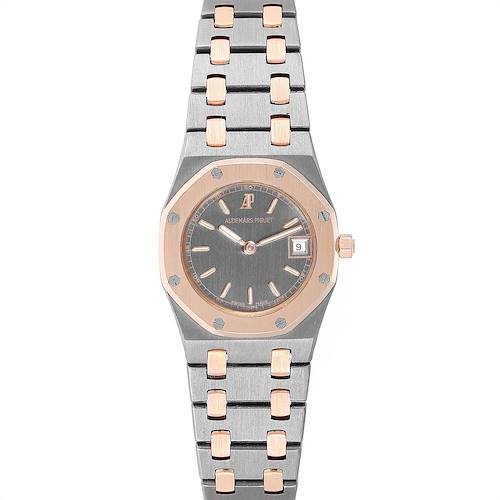- CALL US (404) 814-1814
- LIVE SUPPORT
- EMAIL US
-
WISHLIST (0)
-
CART(0)

Women's Royal Oak | Audemars Piguet Watch Collection
35 MATCHES FOUND
IN STOCK
SwissWatchExpo ARCHIVE - RECENTLY SOLD
Audemars Piguet Royal Oak Collection

The Audemars Piguet Royal Oak is the most famous creation of the manufacture, whose impact of the world of luxury watches is unmatched. The demand for steel luxury sports watches today is unprecedented – and it was the Royal Oak that started it all.
Introduced in 1972, it was the company’s saving grace from the effects of the Quartz Crisis, with its pioneering use of geometric design and stainless steel, at a time when luxury watches were made of precious metals like gold or platinum. With its success, it didn’t just save a company – it single-handedly created a new genre of watches.
From the classic steel model, the iconic porthole design of the Royal Oak has been interpreted in various metals and materials, in sizes ranging from men’s to women’s, and incorporating complications that showcase the technical and aesthetic expertise of the brand. Fifty years on, the Royal Oak still challenges convention with constant upgrades and innovations that suit the tastes of just about every watch collector.
Explore our selection of Audemars Piguet Royal Oak watches at SwissWatchExpo.com.
A BRIEF HISTORY OF THE AUDEMARS PIGUET ROYAL OAK
The Audemars Piguet Royal Oak came about as a response to the Quartz Crisis of the 1970s – but it exceeded expectations by becoming a genre-defining timepiece.
At the beginning of the decade, Audemars Piguet, like most of the Swiss watch industry, suffered significant financial loss due to the rising popularity of Quartz watches from Japan. In 1971, Audemars Piguet realized that they needed a disruptive change in order to save the company from financial collapse. Based on some feedback from the Italian market, they began working on a steel luxury watch – a sporty yet elegant timepiece that was totally new at the time.
They commissioned Gerald Genta, a designer from Geneva who was already famous for several groundbreaking creations: the Omega Constellation, the Patek Philippe Golden Ellipse, and the Polerouter from Universal Genève.
On the eve of the 1971 Basel Fair, Georges Golay, the company’s managing director, called Genta to request for the design, which was needed the next morning. The brief was for an “unprecedented steel watch", a sporty creation that is also suited for all occasions.
Gerald Genta’s design was inspired by traditional deep sea diving helmets and a ship’s porthole. The result was a wide, octagonal bezel with eight hexagonal screws exposed on the bezel. Connecting the rubber seal to the case, these screws served both a practical and aesthetic function.
Genta also incorporated an integrated steel bracelet into the design, which tapers as it meets the clasp. The executives at Audemars Piguet liked the idea so much – the watch was approved as it was.
The watch was named Royal Oak, after a series of eight vessels used by the British Royal Navy. These ships, in turn, took their name from the ancient hollowed oak tree where King Charles II of England hid to escape during the Battle of Worchester in 1651. It made its debut in the 1972 Basel fair.
Apart from its ingenious design, the Royal Oak was also given a premium price. Introduced at $3,000 Swiss Francs, it was more expensive than a gold Patek Philippe, and about ten times the cost of a Rolex Submariner at the time. Steel proved to be much harder to hand-finish to the standards that AP wanted, hence the price.
It placed the Royal Oak in the haute horology category and sent the message that high end timepieces need not be produced in precious metals. It was the design, the meticulous finish, and the movement that mattered.
Success was a slow process for the Royal Oak – it took them almost 3 years to sell the first production run of 1,000 pieces. Nonetheless, it made an impact on the industry with its bold geometric design and thin profile made possible by its movement, the caliber 2121.
The Royal Oak continued Audemars Piguet’s history of experimenting with unconventional forms of design. Over the decades, AP introduced many variations of the classic Royal Oak, expanding the line to include precious metals, complications, strap options, as well as modern movements.
- 1981 – the first Royal Oak Perpetual Calendar was introduced. At the time, it was the world’s thinnest model of its kind, thanks to the caliber 2120/2800.
- 1993 – to mark the 20th anniversary of the Royal Oak, AP introduced the Royal Oak Offshore – a sportier and more masculine take on the original. Designed by Emmanuel Gueit, it was intended to cater to younger watch collectors and sport enthusiasts.
- 2002 – the Royal Oak Concept was introduced as a 30th anniversary tribute to the Royal Oak. Designed by Claude Emmenegger, it was a “lab watch” that introduced avant garde design and ultra-resistant materials to the brand. The inaugural Royal Oak Concept was the first watch to borrow a superalloy from the aeronautical industry – the alacrite 602, which at the time was the hardest material available.
- 2010 – Audemars Piguet introduced the Royal Oak Equation of Time, which combines four high complications: a perpetual calendar, a moon phase indicator, and the equation of time – a function which displays the difference between the length of the “true” solar day and the mean solar day.
- 2012 – the 40th anniversary of the Royal Oak was celebrated with the updated ref 15202, a modern iteration that is true to the original Royal Oak.
- 2022 – Audemars Piguet marks the 50th anniversary of the Royal Oak with four new “Jumbo” versions that replace the ref 15202: one in yellow gold, rose gold, steel, and platinum. The new ref 16202 versions are each equipped with the new and more precise movement called caliber 7121, which was five years in the making.
Fifty years since it rocked the watch industry, the appeal of the Audemars Piguet Royal Oak is stronger than ever. To this day, the company continues to improve on their iconic creation with regular upgrades and compelling new variations, all while keeping the classic design of the Royal Oak alive.
ABOUT THE AUDEMARS PIGUET ROYAL OAK COLLECTION
The Audemars Piguet Royal Oak was made famous for its trailblazing use of steel when most watches were made of precious metals. Today, those on the market for a Royal Oak have a myriad of choices – encompassing everything from classic steel or gold models, to those crafted from exotic materials such as titanium, ceramic, and forged carbon fiber.
The collection has also evolved to include uber complex haute horology pieces that can display the difference between mean time and star time. Here are the sub-collections within the Royal Oak Offshore line.
ROYAL OAK
The classic time-and-date Royal Oak watch comes in two-hand versions featuring the Tapisserie dial. Men’s models come with self-winding movements. Those who seek the timeless look of the original Royal Oak can choose between the 15202ST or the thicker 15300ST, both of which measure 39mm. Those who prefer larger pieces can go for the 41mm 15400ST and its successor, the ref. 15500ST.
Royal Oak models also come in women’s sizes which measure between 33 and 37mm in diameter. These watches boast the classic Royal Oak design DNA, although the 33mm editions are powered by quartz calibers. Moreover, select versions are embellished with diamonds on their bezels, dials, or cases.
ROYAL OAK “JUMBO” EXTRA THIN
The original Royal Oak was called “Jumbo” because of its 39mm case which was large for its time. For the 50th anniversary of the watch, the Royal Oak “Jumbo” Extra Thin ref 16202ST comes equipped with a new extra-thin movement – a first in its half-century history – the in-house developed and manufactured caliber 7121 which offers 55 hours of power reserve.
ROYAL OAK CHRONOGRAPH
The first Royal Oak Chronograph was introduced in 1997, four years after the introduction of the Offshore. It successfully combined a chronograph movement with the classic Royal Oak look: the case measures 39mm across and the chronograph registers are subdued enough to retain the Tapisserie dial.
ROYAL OAK TOURBILLON
The Royal Oak Tourbillon combines the classic Tapisserie dial with a tourbillon aperture at 6 o’clock. The tourbillon mechanism constantly rotates the balance wheel, balance spring, and escapement while the movement is running.
In 2020, AP introduced the first Royal Oak Flying Tourbillon which features the more complicated tourbillon design which is only held on one side. In 2022, for the Royal Oak’s 50th year anniversary, the flying tourbillon is combined with a fully skeletonized dial display, thereby stripping the classic Tapisserie dial decoration.
ROYAL OAK DOUBLE BALANCE WHEEL OPENWORKED
In 2016, the Double Balance Wheel Openworked concept was introduced to the Royal Oak collection. Audemars Piguet’s patented double balance wheel mechanism uses a balance staff carrying one balance and one hairspring on each side. This results to an improved weight balance, offering decreased friction and more stability.
ROYAL OAK PERPETUAL CALENDAR
The Royal Oak Perpetual Calendar features the most classic complication in all of watch making – featuring the date, day of the week, month, moon phase, and the essential leap year indication at 12 o’clock on the “Grande Tapisserie” decorated dial.
The Royal Oak Perpetual Calendar also comes in an openworked version, which dresses the artistic skeleton sapphire dial and the movement’s visible rose gold parts in black ceramic.
AUDEMARS PIGUET ROYAL OAK REFERENCE NUMBERS
Like most watch manufacturers, Audemars Piguet uses reference numbers to properly document the manufacture and sale of their watches. Audemars Piguet watches are assigned three codes: their movement number, case and serial number, and reference number.
The movement number is engraved next to the balance wheel. The case number or the serial number is engraved on the outside of the caseback.
The AP serial number comes with a letter that corresponds to the manufacturing series. This estimates the production date of AP watches from 1975 onwards, as follows:
A Series – 1972 to 1975
B Series – 1976 to 1979
C Series – 1980 to 1986
D Series – 1987 to 1994
E Series – 1994 to 2000
F Series – 2001 to 2007
G Series – 2008 to 2010
H Series – 2011 To 2012
I Series – 2013 to 2015
J Series – 2016 onwards
Audemars Piguet uses a randomized system for reference numbers. The entire reference number is composed of 17 alpha-numeric digits, but it is more common to refer to models using only the first 7 digits, composed of a 4 or 5-digit number and two letters.
The letters that come after the reference numbers (e.g. 15300ST) tells us the type of metal used for the watch case, as follows:
BA – Yellow Gold
BC – White Gold
ST – Steel
OR – Rose Gold
PT – Platinum
TI – Titanium
The rest of the reference number is composed of a randomized set of numbers that marks their sequence in the production.
COMMON QUESTIONS ABOUT THE AUDEMARS PIGUET ROYAL OAK
The Audemars Piguet Royal Oak defied the conventions of watchmaking with its porthole-inspired case, geometric design, integrated bracelet, and steel construction. It holds its place as one of the most iconic watches ever created.
WHAT IS A ROYAL OAK WATCH?
The Audemars Piguet Royal Oak is the most famous creation of the Swiss manufacture. It was the world's first steel luxury sports watch when it debuted in 1972. In addition to the material, the design caused quite an uproar. Created by renowned watch designer Gérald Genta, the original Royal Oak came with an integrated bracelet and porthole-inspired octagonal bezel with eight decorative screws.
Modern models retain these classic characteristics, even as the line expanded to include precious metal and complicated designs.
WHAT IS THE DIFFERENCE BETWEEN ROYAL OAK AND ROYAL OAK OFFSHORE?
The Audemars Piguet Royal Oak was introduced in 1972, after which it became the first steel luxury sports watch.
By 1993, the company decided on creating a more masculine and sportier version of the classic Royal Oak to attract younger audiences and sport enthusiasts – the result was the Royal Oak Offshore.
Both the Royal Oak and Royal Oak Offshore possess a porthole-shaped case and geometric design. The Royal Oak has thinner profile, with the cases for men’s watches ranging from 39 – 44mm, while the Royal Oak Offshore range from 42 – 45mm.
Their chronograph versions also differ – the Royal Oak Chronograph sports a 3-6-9 layout, while the Royal Oak Offshore Chronograph offers both standard and vertical versions.
DO AP ROYAL OAK WATCHES HOLD THEIR VALUE?
Audemars Piguet belongs to the “Holy Trinity” of watch manufactures, alongside Patek Philippe and Vacheron Constantin. These 3 companies have been at the forefront of watchmaking and set the standard for design and craftsmanship.
Aside from their inherent prestige, Audemars Piguet produces about 50,000 watches per year (as of 2022), which is a small number compared to other watch brands that produce more than a million units annually.
With their rich heritage, exceptional quality, timeless design, and limited availability, Audemars Piguet watches such as the Royal Oak have a firm grip on their value.




